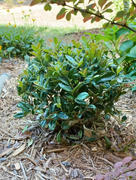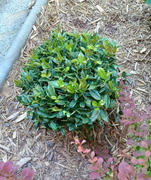* Images shown are of mature plants
My FGT Yard Planner
You'll need to log in or create an account in order to save this item

Have questions? Talk with our Plant Experts (800) 973-8959
Carissa Holly Care
View Full Planting & Care Instructions
Sunlight Plant your Holly in an area with full to partial sun - at least 4 hours of sunlight daily.

Watering Water weekly, or more often in extreme heat. Water when the soil is dry 2-3 inches down.

Fertilizing Fertilization isn't required for your Holly, but you can apply an evergreen fertilizer in the spring as needed.
Glossy Green Leaves, Perfect for Containers or Hedges
The Carissa Holly features the holly’s signature glossy, green leaves, and a rounded growth that makes it perfect for low hedges.
You'll love the Carissa Holly as a foundation or container plant, too. Its dark evergreen color works well as a background for flowering plants in your landscaping. An added benefit? It attracts birds and pollinators, while remaining unappealing to deer.
This shrub is perfect for adding color to compact spaces, with a mature height and width of four feet and a low canopy. It's also slower-growing than other holly varieties. Even better? It's low-maintenance, tolerant of drought and many different soil types. Just plant, water, fertilize once a year and prune as needed to maintain its shape.
Add this easy-growing, versatile evergreen to your landscape today!
Why Fast-Growing-Trees.com is Better
We plant, grow and ship your Carissa Holly with care, making it a must-have for your yard. And since our trees ship with stronger, healthier root systems, it’s ready to grow as soon as at arrives at your door.
If you love the eye-catching elegance of the holly with a versatile size and shape, this is the evergreen for you. Order your Carissa Holly today!
Pollination Info
Carissa Holly Pollination
We carry male and female hollies at our nursery, and you will need both to produce berries on the female plant. However, hollies are hard to tell apart when they are not fruiting, and we can’t guarantee whether you will receive a male or female. For best results, we suggest planting in groups to enjoy berries on the female plants and lush greenery on both year-round.
Planting & Care
1. Planting: Plant your Carissa Holly in an area that receives full to partial sunlight (4 to 8 hours of sunlight per day). For a hedge or privacy screen, plant your Hollies about four feet apart.
When you're ready to plant, dig a hole that's about 2 to 3 times the width of the root ball (and just as deep), place your Carissa Holly and back fill the soil. Add organic material to your soil to lighten the texture and improve drainage. Finally, mulch the surrounding soil to preserve moisture and water once planting is complete.
2. Watering: Keep soil moist until your tree is established. Once Carissa Holly Trees are established, they're drought tolerant and only need extra water during dry spells. Until then, we recommend watering once weekly, or checking the surrounding soil for dryness (use your finger to check the soil about 2 inches down).
3. Fertilizing: Each year, in early spring, fertilize your Carissa Holly with a slow-release fertilizer for an acid-loving shrub (like our Holly-Tone Fertilizer).
Shipping Details
Estimated Shipping Time: Most orders ship immediately. As noted on the website, some items are seasonal, and may only ship in spring or fall. Once your order is shipped, you'll receive an email with a tracking number.
| Amount of Order | Shipping Charge |
|---|---|
| Less than $129 | $19.95 |
| $129 + | FREE SHIPPING! |
Product Details
| Mature Height: | 3-4 ft. |
| Mature Width: | 4-6 ft. |
| Sunlight: | Full Sun |
| Growth Rate: | Moderate |
| Botanical Name: | Ilex cornuta 'Carissa' |
| Does Not Ship To: | AZ,OR |
| Grows Well In Zones: | 7-9 outdoors |
| Your Growing Zone: | # |

Growing Zones: 7-9 outdoors
(hardy down to 10℉)Customer Reviews & Photos
- Reviews
- Questions
- growth
- gallon root ball
- rebound
- transplant shock
- success
Rough start but they are bouncing back
We planted these in late February in zone 7b. They struggled at first and we were concerned they wouldn't survive. I guess it was just transplant shock because they have bounced back. 3 of the 4 are rapidly growing. The 4th is the last to get sun in the morning and is having a slower rebound, but there is new growth.
Nice little plant
Everything fine so far but it takes a while to judge success. So far they seem to be doing very well.









